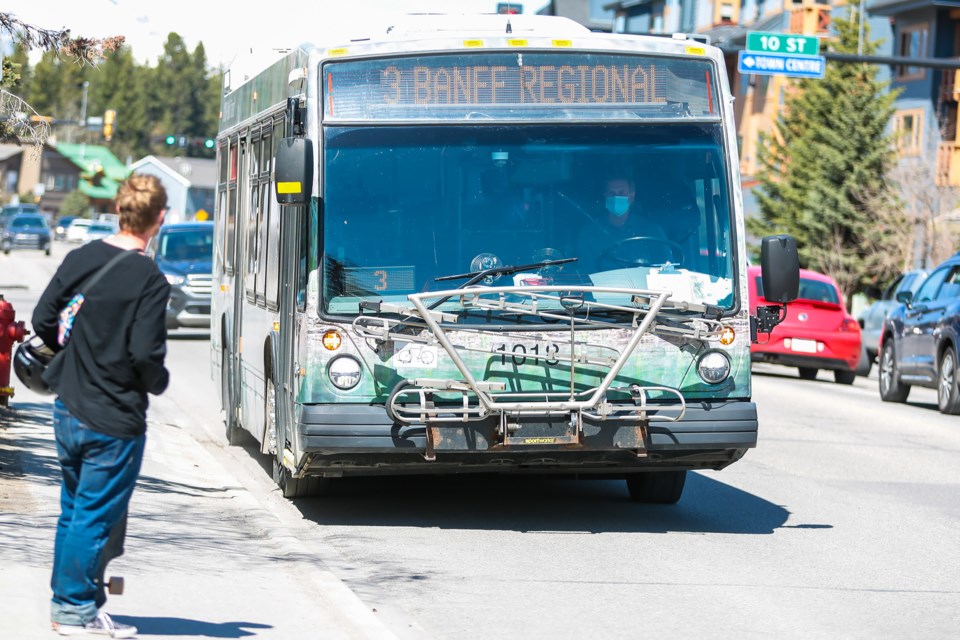CANMORE – The Town of Canmore's finance committee has voiced support for continuing to use paid parking funds for fare-free public transit.
While no motions were made, the committee expressed an intent for the new revenue to help offset expenses for the program and free public transit for local routes as staff looked for guidance now the paid parking program has fully rolled out.
“I see all of this either expanding the frequency or the reach,” said Mayor Sean Krausert during day two of the committee's review of the 2023 budget on Nov. 10. “The more you can do the better as far as local transit goes.”
The original purpose for the paid parking reserve was to help with improvements to paid parking, fund fare-free transit and cover costs of potential intercept parking or shuttle services.
But with a better financial idea of what revenues paid parking can bring in, Town staff were aiming for a better idea of the overall goals with the numerous options available.
From June 29 to Sept. 29, the paid parking program brought in about $836,000 in gross revenue. Quarry Lake accounted for $184,000 and the remaining $652,000 was from the Town Centre.
“What is important from administration's point of view is we have a suite of council-approved policies and documents that says this is our interim goal… It doesn’t mean these other options are more or less valid,” said Whitney Smithers, the Town’s general manager of municipal infrastructure.
“I think it’s important for finance committee and council to have that discussion about how the decisions are going to be made on how the allocation of paid parking revenue move us toward or away from or sideways from our goals.”
Town council committed to the creation of a grant program for some revenues to go to the downtown core. However, Town staff and the Downtown BIA will have to establish the framework of the program. Town staff have suggested a placeholder of $50,000 annually until the grant parameters are approved by council.
Early talks have also been ongoing between the Town and the Rocky Mountain Heritage Foundation (RMHF), which may result in a potential ask of half the net parking revenues from Quarry Lake paid parking going to RMHF.
The Town spends about $165,000 each year in operating and maintenance costs and receives about $13,000 for facility bookings at the lake. There has been no formal ask from RMHF and greater discussions would take place after the budget.
Krausert noted Quarry Lake land is owned by RMHF as private property, but is largely used for public purposes.
“It’s used publicly, but it’s privately owned,” he said.
Town staff also presented an option to increase the parking fee during the high season by $1, which could generate an extra $300,000 a year.
The Town of Canmore's goal is to have 40 per cent of travel be done other than by way of vehicles by 2030 with a focus on more use of public transit, walking and cycling. It came out of the Town’s Integrated Transportation Plan and climate action goals to reduce greenhouse gas emissions, while also lessening the growing traffic congestion. Revenue generated would also aid in covering the fare-free public transit available in Canmore.
During the three months from June 29 to Sept. 29, 11,684 resident permits were processed, 9,818 vehicles were registered and 183,057 total parking sessions were counted. Of those, residents made up 42,117.
In 2023, the Town estimated revenue of $1.15 million, but net revenue of roughly $776,000 after expenses are factored in. Similar numbers in 2024 are expected.
Both 2023 and 2024 would see roughly $300,000 moved to fare-free transit costs with about $470,000 each year going to the paid parking reserve. By the end of 2024, a reserve balance of $1.2 million is expected.
In 2022, Canmore was on the hook for $1.53 million for Roam transit requisitions. It will increase to $1.8 million in 2023 and an estimated $1.84 million in 2024. With paid parking reserves going to transit, it has offset the taxpayer-funded portion of the Canmore local routes.
The Roam requisition increases are for the new three-year pilot Grassi route planned for 2024 as well as an increase in service hours for the Route 3 regional bus and weekday and weekend Canmore local service. It has not yet decided if the Grassi Lakes route will be free or pay-to-use since it’s a regional route.
Roam transit is also undergoing a transit service review of Canmore routes, so Coun. Joanna McCallum, who is chair of Bow Valley Regional Transit Services Commission (BVRTSC), said the requisition costs are likely to be impacted depending on the recommendations from the review.
However, if more of the paid parking revenue is dedicated to Canmore local routes, it would mean less of a contribution needed from property taxes, leading to a decrease in the mill rate.
“I think we’ll have a lot of debate about it this year, but there’s still some guesswork and we could invest time on putting more into the policy on this,” said Coun. Tanya Foubert, a board director and Canmore representative on BVRTSC.




